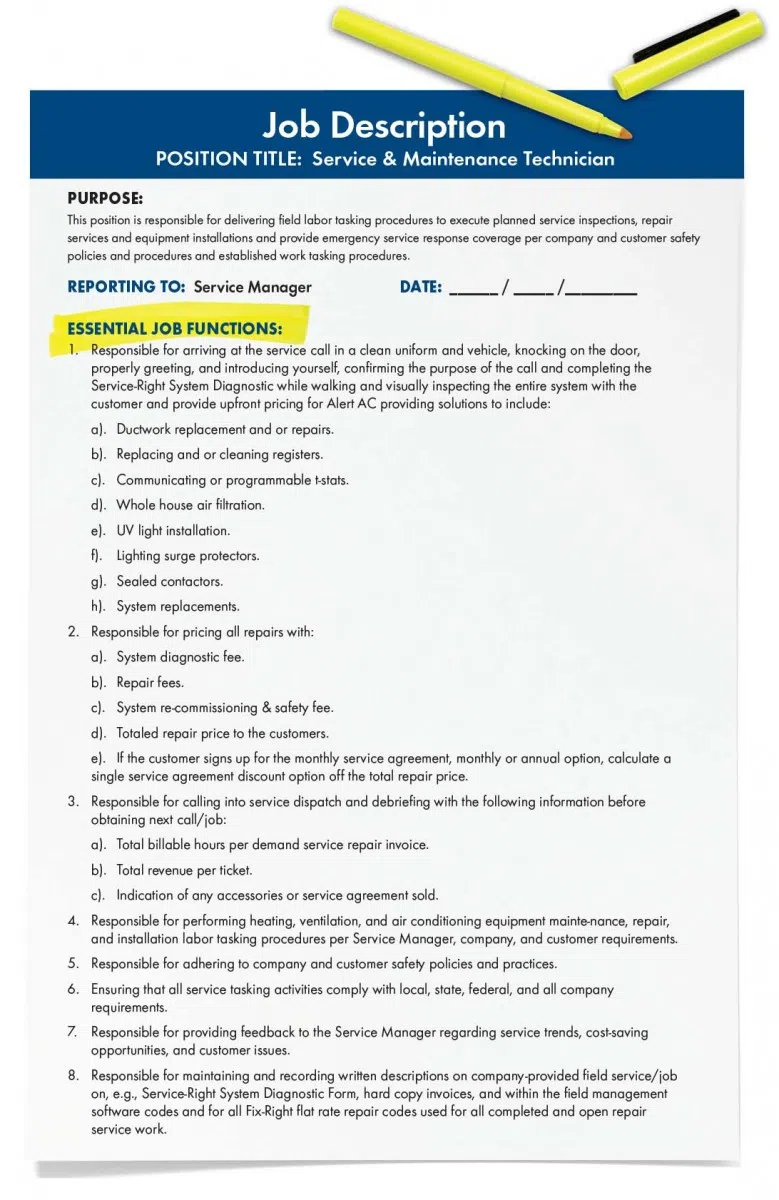This is the final installment of a six-part series designed to be a complete A-Z on how to sell and organize for commercial service agreements. The Selling Commercial Service Agreements series includes the following topics:
- Preparing for service agreement surveys
- Equipment and system surveying and data gathering
- Profitable pricing strategies to win the business
- Proposal writing strategies
- Hiring and compensating sales service sales reps
- Organizing for service agreements
Part VI: Organizing for Service Agreements
To attract and retain customers and make money offering service agreements, you must implement standardized business processes that systematically, seamlessly, and profitably execute service agreement and ancillary service work.
Several areas are critical to the service department processes and combine to form the seamless delivery of the service agreement business. Each requires special attention and understanding.
Interdepartmental Communication Procedures
Service Operations needs information gathered at the customer job site; and the scope of work and pricing information from Sales. Therefore, an internal communication process that systematically and accurately transfers critical data from customer to Sales to Service Operations is needed.
The most effective tool for this is an interdepartmental communication and job-booking process and procedure that includes the following minimum information and documentation:
1. A job agreement/authorization document to communicate job-entering information to Accounting, Sales, and Operations Management.
Accounting receives this document to enter financial information, attachment of all booking documents, as well as, to authorize paying commissions. This information includes:
- Bill location
- Job location
- Work category
- Estimated cost
- Gross profit margin
- Effective start date
- Sales signature
- Approval signature
2. An estimate document is used by Accounting to enter job costs budgeted by Sales to establish sell price and gross profit margin, and by Operations to allocate resources. This information includes:
Itemized estimate by equipment type and location:
- Annual inspection labor
- Annual inspection materials
- Operational inspection labor
- Operational inspection materials
- Repair labor, repair materials
- Filter services
- Special services
Subcontractors:
- Estimate summary by category
- Total cost
- Total gross profit
- Total sell price
3. A proposal document, once executed by the customer and company, is used by Sales and Operations to establish job location, and contractual obligations for both the customer and company.
This information includes:
- Customer name
- Job location
- The scope of work of your offering(s) to include:
- The equipment maintenance tasking procedures
- The frequency of maintenance tasking for each piece of equipment
- The equipment component repair liability coverage (included/excluded)
- The overtime emergency response coverage (included/excluded)
- The special service(s) tasking procedures for specific equipment (included/excluded) such as:
- Filter changes, quality of filtration, and frequency
- Water treatment
- Testing and diagnostics
- Start-up and shut down procedures
- Summer/winter change over
- The price(s), if a multi-year offering
- Payment distribution annually
- Early pay discounts
- How adds/deducts will be handled
- Terms and conditions of the offering
- Term of agreement
- Causes of termination
- How disputes will be handled o Liability inclusions/exclusions
- Offer and acceptance
- Signature of sales rep
- Authorization signatures of both parties
- Date of binding agreement
4. A service agreement plan worksheet document is used by Operations to establish per inspection the manpower loading by piece of equipment in total and by month. This information includes:
- Job name
- Internal account or agreement tracking number
- For each covered equipment:
- Equipment estimating table ID number
- Equipment description
- Equipment size (BTU, Tons, Hp)
- Tasking labor grade level
- Per inspection labor tasking hours
- Total annual inspection labor hours
- Total per month inspection hours
5. A service agreement plan summary document is used by Operations to establish the scope of work, the per inspection labor, material, and job-site specific requirements and for assigning field labor resources. This information includes:
- Job name
- Job address
- Internal account or agreement tracking number
- Sales reps name
- Assigned technician(s)
- Effective start and end dates
- Customer name
- Customer contact
- Contact phone number
- Extra work authorized by name
- Summary of scope of maintenance agreement services
- Program coverage
- Job site mobilization considerations
- Labor plan schedule summary
- Material plan schedule summary
- Operation management approval signature
- Approval date
- Agreement document checklist
Service-Agreement Start-Up Procedure
The above documents help to implement a service agreement internally, but they do not guarantee customer satisfaction.
It is very important to start the service agreement as close to the sales date as possible to reassure the customer’s decision to go with your company, as well as to reduce business risk on repair-and-replace coverage agreements. Below is a procedure to assure an appropriate startup and execution of the service agreement to meet both the customer and company’s requirements.
- Sales rep forwards the following documents to sales manager or service management for approval: job agreement/authorization; survey; estimate; proposal; service agreement plan worksheet; service agreement plan summary.
- Sales manager approves and sends to the service manager; or the service manager approves the job agreement/ authorization form and coordinates the start-up meeting time and date within five days of sale and should include all key stakeholders: sales manager, sales rep, service manager, and technician if special conditions and or account dollar size merits.
- Sales rep schedules first site visit meeting with customer within five days of start-up meeting.
- Service manager negotiates and executes any subcontract work and coordinates and schedules onto job location.
- Service manager communicates labor schedule to dispatch for each inspection.
- Service manager approves and forwards the service agreement plan summary to Accounting for entering budget costs and automatic billing set up.
- Service manager communicates to field personnel the service agreement scope of work, special job site special conditions, and provides for each piece of equipment the inspection tasking procedures.
- Sales rep meets with assigned technician(s) and conducts introduction and walk through scope of work and customer communication and job specific requirements.
- Service technician records and reports to the service manager any equipment that is not maintainable. It is highly recommended that the contractor use the most experienced technician to conduct first inspections on agreements that include repair labor and or repair materials coverage liability.
- Service manager coordinates the estimating of any repair costs to bring equipment up to original design operation. If scope of repair is significant in dollar value, the service manager may request sales rep assistance to propose and sell repairs as a lump sum or not-to-exceed project. Otherwise, the service manager should contact the customer to coordinate minor repairs.
Labor, Material, and Subcontract Scheduling
The proper labor and material scheduling is critical to both customer satisfaction and company profitability. To deliver customer satisfaction, the service agreement must have allocated labor resources closest to the job site that have the right customer care and technical skills and have the right tools, equipment and maintenance materials.
Assigning Labor to Technicians
Residential/light commercial contractors usually can assign technicians to any or all service agreement maintenance tasking. The service agreement can be assigned by the dispatcher to the closest available technician during any given day.
However, large heavy commercial contractors have a much more diverse labor force due to the greater varying degree of technical and customer care skill sets requirements. It is estimated that 85 percent of all commercial service agreement work will involve unitary equipment less than 20 tons in capacity. Therefore, it is a common practice to price all service agreements using the highest or highest average labor grade level. This practice enables the large commercial service manager to assign the majority of maintenance tasking to a wider range of their service technician labor force. However, high skill level (high cost) technicians who can work on large/ complex primary systems over 20 tons are usually limited in number and must be carefully managed to make sure this extending.
Most large service agreements require conservative pricing strategies to compete against good competition. Large service agreements would be defined as those that have 32 hours or more per inspection labor hours. This size opportunity usually requires that the agreement be priced based on how it will be staffed during execution. An example of this strategy would be using a high skill level technician to do the start-up inspections on the chiller plant and the low level technician to do all the operating inspections.
Technician Communication Requirements
Our customers typically require fast response to equipment failure situations as well as want their assigned service technician to know what is or are not included under the scope of their service agreement. Therefore, it is recommended that contractors implement a communication process to inform the assigned service technician what to do in an equipment failure situation or when special services are required. Additionally, it is very important for the service technician to know beforehand what procedure to follow when a repair arises that is not covered under the scope of the service agreement.





